Solved Examples and Worksheet for Extending and Recognizing Geometric Patterns by its Rules
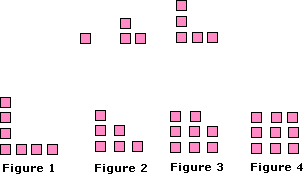
A. Figure 1
B. Figure 2
C. Figure 3
D. Figure 4
Step: 1
The difference between the number of squares in the adjacent figures is 2.
Step: 2
The number of squares in the third figure = 5
Step: 3
The number of squares in the fourth figure = 5 + 2 = 7.
Step: 4
So, amongst the given figures, Figure 1 suits the given pattern.
Correct Answer is : Figure 1

A. Figure 1
B. Figure 2
Step: 1
The rule for the pattern is to place the 2 figures shown in 1st and 2nd arrangements in order and repeat the arrangements to obtain the next figure in the pattern.
Step: 2
So, the next figure in the pattern is


Correct Answer is : Figure 2
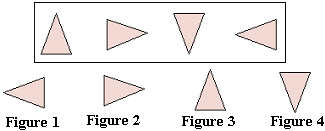
A. Figure 3
B. Figure 2
C. Figure 4
D. Figure 1
Step: 1
The rule for the pattern is to rotate each figure by 90o clock wise direction to obtain the next figure in the pattern.
Step: 2
So, the next figure in the pattern is


Correct Answer is : Figure 3
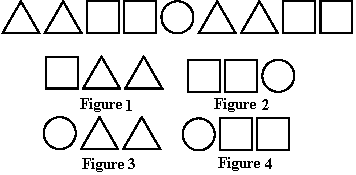
A. Figure 1
B. Figure 2
C. Figure 3
D. Figure 4
Step: 1
Given figure pattern is "two triangles followed by two squares which are followed by one circle".
Step: 2
Looking at the given pattern, we find that the next 3 shapes of this pattern are "one circle followed by two triangles".
Step: 3
So, amongst the given figures, Figure 3 suits the given pattern.
Correct Answer is : Figure 3
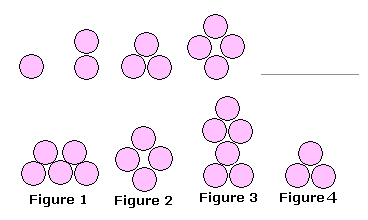
A. Figure 4
B. Figure 3
C. Figure 2
D. Figure 1
Step: 1
The given pattern is "1 circle, 2 circles, 3 circles, 4 circles,...
[Add 1 circle to the previous figure to get the next figure.]
Step: 2
So, the next figure would be 5 circles.
Step: 3
Among the choices, Figure 1 is the correct answer.
Correct Answer is : Figure 1

A. square, triangle
B. circle, triangle
C. circle, square
D. triangle, circle
Step: 1
Given figure patttern is "one circle followed by one triangle, which is followed by one square".
Step: 2
Looking at the given pattern, we find that the next two figures would be circle and a triangle.
Correct Answer is : circle, triangle

A. Figure 2
B. Figure 4
C. Figure 3
D. Figure 1
Step: 1
The rule for the pattern is to place the four different figures repetitively to obtain the next figure in the pattern.
Step: 2
According to the pattern shown, the next figure , that is the 11th figure would be Figure 3.
Correct Answer is : Figure 3
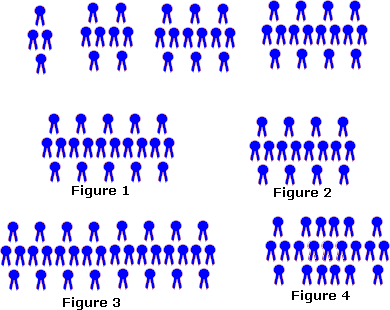
A. Figure 3
B. Figure 2
C. Figure 4
D. Figure 1
Step: 1
Make a table for the figure pattern shown.
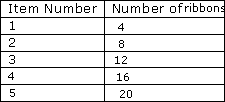

Step: 2
From the table, we see that the number of ribbons in each item increases by 4.
Step: 3
The rule for the pattern shown is 4n, where n is the item number
Step: 4
The fifth item in the figure pattern shown contains 20 Ribbons.
Step: 5
So, Figure 1 is the fifth item in the figure pattern shown.
Correct Answer is : Figure 1
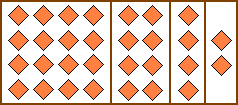
A. divide each arrangement by 2
B. subtract each arrangement by 8
C. multiply each arrangement by 2
D. add each arrangement by 4
Step: 1
Looking at the pattern shown, we find the rule that " divide each arrangement by 2".
Correct Answer is : divide each arrangement by 2
- Multiplication Arrays-Gr 4-Solved Examples
- Problems on Multiplication and Division Involving Unknown Quantities-Gr 4-Solved Examples
- Application of Multi-Step Problems-Gr 4-Solved Examples
- Application of Estimating Sums and Differences-Gr 4-Solved Examples
- Factors of Whole Number to 100-Gr 4-Solved Examples
- Multiples of Whole Numbers through 100-Gr 4-Solved Examples
- Prime and Composite Numbers-Gr 4-Solved Examples
- Writing Numeric Patterns given the Rule-Gr 4-Solved Examples


